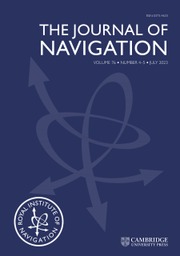No CrossRef data available.
Article contents
A Critical Table for Sextant Corrections
Published online by Cambridge University Press: 18 January 2010
Extract
It is the present usage by the National Physical Laboratory and the Trade to give, on its Certificate, the ‘constant’ (graduation and centring) errors of a sextant only at stated points on the scale. If these errors are of a magnitude which is worth while applying as a correction, this usage is not quite what the user requires. The N.P.L. Class A Test, issued for instruments reading directly to 10″ (or o′·2 in the case of decimal subdivision) allows combined graduation and centring error up to 40″ or 4 scale divisions of the micrometer or vernier; the Class B Test for instruments graduated to 20″ permits such error up to 2′ or 6 scale divisions. Thus, even with instruments that pass these tests, it may be worth the marine navigator's while to apply the error as a correction. What he wants to know, however, are the limits of such errors as are worth his while to apply. In other words, he requires a Critical Table of Corrections, of the type used in the Air Almanac and in certain mathematical tables by L. J. Comrie, by whom, it is understood, the method was introduced.
Information
- Type
- Research Article
- Information
- Copyright
- Copyright © The Royal Institute of Navigation 1948
References
page 266 note * That is, not unless some new instrument is developed. It is interesting to speculate as to what might be done if it became possible to measure the bearing of an astronomical body with an accuracy as great as that with which the sextant measures its altitude.
page 267 note * Hughes, A. J., 1938, The Book of the Sextant. Brown, Son & Fergusson.Google Scholar

